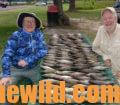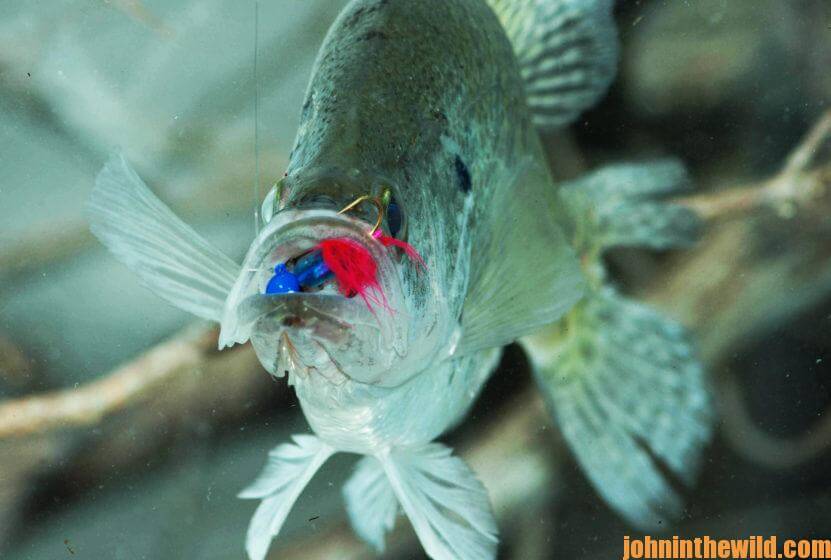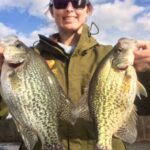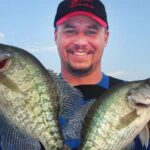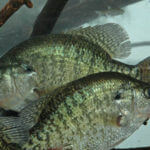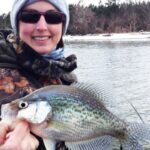Editor’s Note: The most-dependable place to find and catch crappie throughout the spring is locations where the prespawn crappie hold before going to the bank, since crappie don’t all go to the banks at the same time. Nor do they spawn-out all their eggs the first time they move to the banks. A crappie may go to the bank to spawn several times during the spring and then return to its prespawn spots before going back to shallow water to spawn. The crappie also move to prespawn sites to hold before they move offshore to deeper water. Let’s look at where some of the best crappie-fishing guides look for and catch prespawn crappie.
Brad Whitehead of Muscle Shoals, Alabama (https://www.facebook.com/BradWhiteheadCrappie/, owner of Brad Whitehead Fishing Guide Service, 256-484-0834) fishes small watershed lakes in the prespawn for crappie like the Bear Creek lakes in northwest Alabama (http://www.bearcreeklakes.com/about-us.html) and also guides on the Tennessee River on Pickwick (borders Mississippi, Alabama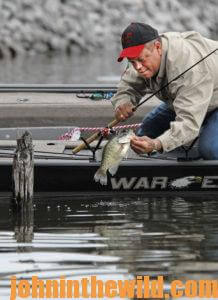 and Tennessee) and Wilson lakes. According to Whitehead, “The Bear Creek lakes include four lakes located in Franklin County, Alabama, just outside of Russellville, Ala. These lakes are 750 acres to 4200 acres in size and were stocked in the 1970s with crappie that weren’t a river strain of crappie. More than likely you won’t catch a 2 or a 2-1/2 pound crappie in Bear Lakes like you will on the Tennessee River, but you’ll catch some good-eating crappie, 9-12 inches long. The water’s very clean and clear. These lake have a winter draw-down that brings them down 10-12 feet below normal pool, starting in December. The lakes don’t refill until the end of February or the first of March. So, unlike in a river, these crappie stay suspended about 99% of the time – all year long. In the prespawn, my boat may be sitting in 40 feet of water, and I’ll start catching crappie in 18-19 foot deep water because that’s where the bait fish here will be holding.
and Tennessee) and Wilson lakes. According to Whitehead, “The Bear Creek lakes include four lakes located in Franklin County, Alabama, just outside of Russellville, Ala. These lakes are 750 acres to 4200 acres in size and were stocked in the 1970s with crappie that weren’t a river strain of crappie. More than likely you won’t catch a 2 or a 2-1/2 pound crappie in Bear Lakes like you will on the Tennessee River, but you’ll catch some good-eating crappie, 9-12 inches long. The water’s very clean and clear. These lake have a winter draw-down that brings them down 10-12 feet below normal pool, starting in December. The lakes don’t refill until the end of February or the first of March. So, unlike in a river, these crappie stay suspended about 99% of the time – all year long. In the prespawn, my boat may be sitting in 40 feet of water, and I’ll start catching crappie in 18-19 foot deep water because that’s where the bait fish here will be holding.
“When the water starts falling in December, the crappie and the bait fish will move out of the creek channels toward the middle of the lake. To catch these crappie, we use a technique called sidepulling. The trolling motor is mounted on the side of my boat. When I have two anglers in my boat, I can pull the boat sideways, and then everyone will be fishing fresh water all day long. Sidepulling also is called side trolling. During the prespawn, we’ll be fishing 1/4-ounce jigs, and each angler will have two rods. We’ll be fishing homemade hair jigs or Slider jig heads
(https://www.sliderfishing.com/), in black or chartreuse. We use the darker-colored jigs because during the prespawn this section of the state has numbers of cloudy and rainy days. We try to cover as much deep water as possible.
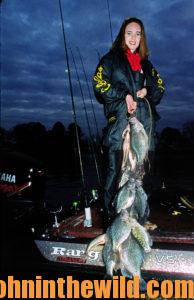 “Once we discover the depth in which the crappie are concentrating that day, then we adjust the length of the line we have out to make sure the jigs will run in the depth of water where we catch our first crappie. In these watershed lakes, once you identify the depth where the prespawn crappie are concentrating, you can troll that same depth to catch more crappie. These crappie are suspended because they’re waiting on the water to rise in these watershed lakes. Once the water level moves up to 8-10 feet more on the bank, the crappie will move to the bank and start spawning. As the water comes up, the crappie will follow that water, until the weather’s warm enough for the crappie to spawn in shallow water.
“Once we discover the depth in which the crappie are concentrating that day, then we adjust the length of the line we have out to make sure the jigs will run in the depth of water where we catch our first crappie. In these watershed lakes, once you identify the depth where the prespawn crappie are concentrating, you can troll that same depth to catch more crappie. These crappie are suspended because they’re waiting on the water to rise in these watershed lakes. Once the water level moves up to 8-10 feet more on the bank, the crappie will move to the bank and start spawning. As the water comes up, the crappie will follow that water, until the weather’s warm enough for the crappie to spawn in shallow water.
“On the Tennessee River on Pickwick Lake, I’ll fish three creeks on the western end of Pickwick, for prespawn crappie – Bear Creek, Indian Creek and Yellow Creek. During February and March, often Pickwick experiences low-water conditions that may cause the crappie to suspend until the lake starts filling up again. Once the water comes up and moves toward full pool, we’ll begin fishing large flats – often in 15-20 feet of water – off the main creek channels. All the crappie in that region will move to these flats in this 15-20 feet of water and will be holding close to the bottom. There’s an abundance of old stumps still left on the bottom in these creeks. The crappie will stage on these stumps before moving into shallow water to spawn.
“But remember, not all crappie spawn in shallow water. I catch numbers of male crappie in that 15-20 foot deep water. Those males are in that depth of water because they’re fertilizing the eggs the females have spawned out at that depth. I’ll still be fishing 1/4-ounce jigs, and we’ll be  sidepulling over these flats. I’ll be pulling the boat as slow as .5 miles an hour up to .8 miles per hour. I’ll be fishing will be black, chartreuse or red jigs with either a red head with a chartreuse grub or a chartreuse head with red hair. We’ll usually catch 50-60 crappie a day, between 11-13 inches long in the prespawn on the river.”
sidepulling over these flats. I’ll be pulling the boat as slow as .5 miles an hour up to .8 miles per hour. I’ll be fishing will be black, chartreuse or red jigs with either a red head with a chartreuse grub or a chartreuse head with red hair. We’ll usually catch 50-60 crappie a day, between 11-13 inches long in the prespawn on the river.”
To learn more about crappie fishing, check out John E. Phillips’ book, “Catch Crappie All Year: Fishing a Single Pole, Using No Boat and Farming Crappie,” available in Kindle and print versions at https://amzn.to/31Ybf0W and click here for the Audible link.
Tomorrow: Identifying the Three Prespawn Crappie Phases with Guide Tony Adams


